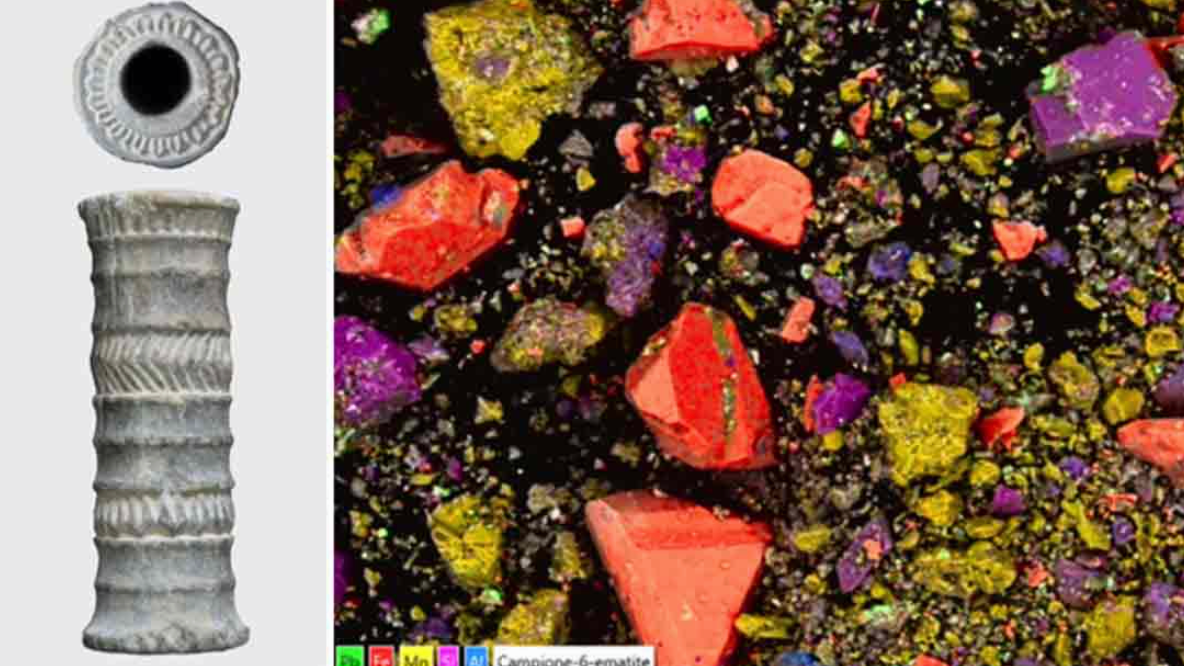Bright-red pigment is one of the earliest examples of Bronze Age lipstick
The bright-red pigment is housed inside an "elegant and valuable" stone vial.

A bright-red pigment housed inside a small stone vial could be one of the oldest known examples of lipstick in the world.
Archaeologists recovered the Bronze Age cosmetic in 2001 in Jiroft, a city in southeastern Iran, after the Halil River flooded and swept through several nearby cemeteries from the third millennium B.C., according to a study published Feb. 1 in the journal Scientific Reports.
The swift water forced the vial, which is made of intricately carved chlorite, to the surface alongside numerous other artifacts, many of which were looted by locals, the researchers wrote in the study. Items that were recovered, including the lipstick, are now part of the Jiroft Archaeological Museum collection.
To learn more about the ancient lip paint, the researchers analyzed the red substance using radiocarbon dating and determined that it was up to 4,000 years old and dated to sometime between 1936 B.C. and 1687 B.C.
"The substance we extracted from the vial was very dark and powdery," study senior author Massimo Vidale, an archaeologist at the University of Padua in Italy, told Live Science in an email. "This container, made of a fine chloritic green rock, replicates the shape of a marsh cane segment — people, at the time, cut canes in segments to be used as cheap containers [for] everyday use. But in this case, the holder is made of an elegant and valuable stone."
Related: Bronze Age 'treasure' was crafted with extraterrestrial metal
The pigment's mixture was predominately made using crushed hematite, an oxide mineral, resulting in its vibrant red color, along with other minerals, such as manganite and braunite, the researchers found. Quartz particles were also added to the mix, either to temper the paste or to add shimmer.
The lip pigment also contained traces of vegetal fibers, which may have been added to scent the product. The pigment itself "bears a striking resemblance to the recipes of contemporary lipsticks," the authors wrote in the study.
Sign up for the Live Science daily newsletter now
Get the world’s most fascinating discoveries delivered straight to your inbox.
Although archaeologists aren't sure who owned the makeup, they do know that beauty products like this one were commonly used by women in Iran during this time period. Other popular products included a black powder called sormeh, which was used as eyeliner, and henna, which was used to dye hair and skin, according to The Circle of Ancient Iranian Studies, a nonprofit educational program.
"The vial's slender shape and limited thickness suggest that it could have been conveniently held in one hand together with the handle of a copper/bronze mirror, leaving the other hand free to use a brush or another kind of applicator," the authors wrote in the study.
An example of such an application can be seen in ancient Egypt's Turin Papyrus 55001, which dates to the 12th century B.C. In that image, a young woman "oints or perhaps paints her lips with a long brush or solid applicator in the right hand, while keeping at the same time with the left a large, round mirror together with a tin, round-bottomed cylindrical cosmetic vial," according to the study.
However, archaeologists are hesitant to declare the artifact the oldest lip pigment in the world.
"At present it might be the oldest lip-paint we know," Vidale said. "But I expect that older examples will be soon identified by other colleagues."
Jennifer Nalewicki is former Live Science staff writer and Salt Lake City-based journalist whose work has been featured in The New York Times, Smithsonian Magazine, Scientific American, Popular Mechanics and more. She covers several science topics from planet Earth to paleontology and archaeology to health and culture. Prior to freelancing, Jennifer held an Editor role at Time Inc. Jennifer has a bachelor's degree in Journalism from The University of Texas at Austin.









